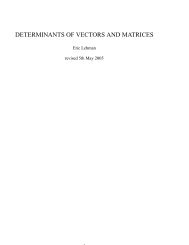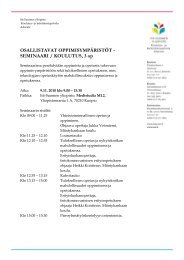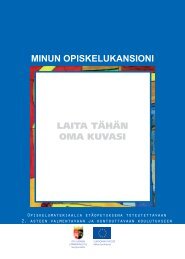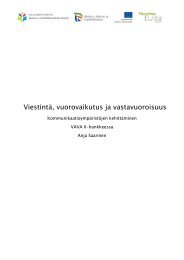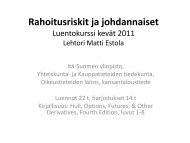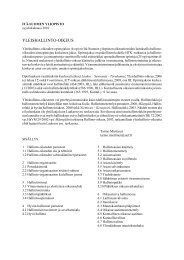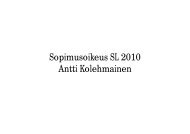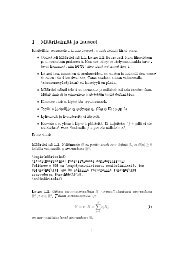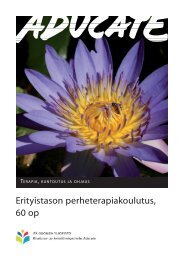Twenty five Years of Educational Reform Initiatives in ... - Joensuu
Twenty five Years of Educational Reform Initiatives in ... - Joensuu
Twenty five Years of Educational Reform Initiatives in ... - Joensuu
Create successful ePaper yourself
Turn your PDF publications into a flip-book with our unique Google optimized e-Paper software.
<strong>Twenty</strong>- <strong>five</strong> <strong>Years</strong> <strong>of</strong> <strong>Educational</strong> <strong>Reform</strong> <strong>Initiatives</strong> <strong>in</strong> F<strong>in</strong>land<br />
Ari Antika<strong>in</strong>en & Anne Luukka<strong>in</strong>en<br />
Department <strong>of</strong> Sociology, University <strong>of</strong> <strong>Joensuu</strong>, F<strong>in</strong>land<br />
(Manuscript for a book on Globalization and Education)<br />
"<strong>Educational</strong> transformations are always the result and the symptom <strong>of</strong> the social transformations <strong>in</strong><br />
terms <strong>of</strong> which they are to be expla<strong>in</strong>ed." (Durkheim 1969; 1977, 92.)<br />
“<strong>Educational</strong> reforms are part <strong>of</strong> or consequences <strong>of</strong> socioeconomic change.” (Husén 1986, 51)<br />
"Equity, participation and welfare state have been known as the major socio-political attributes <strong>of</strong><br />
the Nordic model." (Scand<strong>in</strong>avian Journal <strong>of</strong> <strong>Educational</strong> Research vol. 50, 3, 2006.)<br />
Overview<br />
F<strong>in</strong>land is known for its Sauna, Jean Sibelius, F<strong>in</strong>nish tango, Nokia’s mobile phones and success <strong>in</strong><br />
the PISA assessments. This Nordic country with a population <strong>of</strong> only 5.3 million <strong>in</strong>habitants spread<br />
on a large and sparsely populated land area — though there is a clear migration tendency towards<br />
the capital region and other large cities <strong>in</strong> Southern F<strong>in</strong>land — , and with a small but developed<br />
national economy has been very successful <strong>in</strong> <strong>in</strong>ternational comparisons <strong>of</strong> education and economy,<br />
like <strong>in</strong> the OECD’s Programme for International Student Assessment <strong>in</strong> 2000 and 2003, and <strong>in</strong> the<br />
evaluations <strong>of</strong> the World Economic Forum (OECD 2001; 2004). As late as <strong>in</strong> the 1960s, F<strong>in</strong>land<br />
was more agrarian and less <strong>in</strong>dustrialized than other western European countries, but it was drawn<br />
<strong>in</strong>to the capitalist world economy ma<strong>in</strong>ly by foreign capital and bus<strong>in</strong>essmen already at the end <strong>of</strong><br />
the 19 th century because <strong>of</strong> its forest resources and pulp and paper <strong>in</strong>dustry. Forests were largely<br />
owned by small and medium size farms. In the1960s and 1970s, the F<strong>in</strong>nish society underwent one<br />
<strong>of</strong> the swiftest structural transformations <strong>in</strong> Europe to become an <strong>in</strong>dustrial Nordic welfare state<br />
accord<strong>in</strong>g to the Scand<strong>in</strong>avian or social democratic model. Comprehensive education rationale was<br />
a part <strong>of</strong> this welfare state model. In the 1980s, the economic boom cont<strong>in</strong>ued, but it was followed<br />
by a deep economic depression <strong>of</strong> the 1990s, which <strong>in</strong> relative terms was deeper than the depression
<strong>of</strong> the 1930s. The success <strong>of</strong> electronics, especially Nokia’s mobile telephone <strong>in</strong>dustry, made the<br />
f<strong>in</strong>anc<strong>in</strong>g <strong>of</strong> the welfare state still possible, although with severe cuts and restructur<strong>in</strong>g processes.<br />
S<strong>in</strong>ce the 1990s, the welfare state has transformed <strong>in</strong> the direction <strong>of</strong> a competitive state.<br />
(Antika<strong>in</strong>en 2005; 2006.)<br />
The present F<strong>in</strong>nish education system consists <strong>of</strong> pre-primary education, 9-year comprehensive<br />
school, post-compulsory general and vocational education, higher education and adult education. In<br />
the discussion <strong>of</strong> the PISA results, the significance <strong>of</strong> the pr<strong>in</strong>ciple <strong>of</strong> equity and the status <strong>of</strong> the<br />
comprehensive school system have been stressed. A Nordic group <strong>of</strong> PISA researchers present this<br />
as follows:<br />
The Nordic strategy for build<strong>in</strong>g up high quality and equality <strong>in</strong> education has been based on construct<strong>in</strong>g a publicly<br />
funded comprehensive school system without select<strong>in</strong>g, track<strong>in</strong>g or stream<strong>in</strong>g students dur<strong>in</strong>g their basic education<br />
until the age <strong>of</strong> 16. Part <strong>of</strong> the strategy is to spread the school network so that pupils have a school near their homes<br />
whenever possible or if this is not feasible, e.g. <strong>in</strong> rural areas, to provide free transportation to more widely dispersed<br />
schools. Inclusion <strong>of</strong> special education and <strong>in</strong>structional efforts to m<strong>in</strong>imise low achievement are also typical to<br />
Nordic educational systems. (Lie, L<strong>in</strong>nakylä & Roe, 2003, 8.)<br />
After the establishment <strong>of</strong> the present F<strong>in</strong>nish comprehensive school system <strong>in</strong> the 1970s and early<br />
1980s, the adm<strong>in</strong>istration <strong>of</strong> comprehensive schools and the entire education system was very<br />
centralized. Centralization was considered as a means to carry out the comprehensive school reform<br />
despite the opposition <strong>of</strong> right-w<strong>in</strong>g parties and the association <strong>of</strong> secondary school teachers. In the<br />
late 1980s, a significant change occurred as an <strong>in</strong>cremental plann<strong>in</strong>g paradigm ga<strong>in</strong>ed ground and<br />
the system was decentralized. Schools became more responsible for their own management and<br />
were supposed to make their own curricula accord<strong>in</strong>g to the guidel<strong>in</strong>es given by the National Board<br />
<strong>of</strong> Education. Teachers could choose the pedagogy they applied. Thus, there was a great emphasis<br />
on the pr<strong>of</strong>essional expertise <strong>of</strong> teachers. These measures generated resources for a new<br />
development (Antika<strong>in</strong>en, 2005, 21-32).
The basic values and the vision <strong>of</strong> education as a public service have rema<strong>in</strong>ed unchanged s<strong>in</strong>ce<br />
1968, but <strong>in</strong> the 1990s and 2000s, there has been a trend towards school-based pr<strong>of</strong>iles, stronger<br />
parental choice, ‘customer’ orientation and systematic school evaluation <strong>in</strong> particular. The<br />
consequences <strong>of</strong> these more or less neo-liberal changes and public management measures are under<br />
debate. In F<strong>in</strong>land they have been more modest than <strong>in</strong> many other countries, yet Simola, R<strong>in</strong>ne and<br />
Kivirauma (2002) argue that they represent a historical shift <strong>in</strong> education governance <strong>in</strong> F<strong>in</strong>land and<br />
other Nordic welfare states. We have called the period from 1995 onwards an age <strong>of</strong> restructur<strong>in</strong>g<br />
(Antika<strong>in</strong>en 2006, 238) 1 . However, it is also justified to argue that the F<strong>in</strong>nish case <strong>of</strong><br />
comprehensive education demonstrates that it is possible to <strong>in</strong>troduce greater flexibility and local<br />
autonomy without threaten<strong>in</strong>g the wider goals <strong>of</strong> m<strong>in</strong>imiz<strong>in</strong>g <strong>in</strong>equalities (Antika<strong>in</strong>en ibid.). This<br />
issue is currently under debate.<br />
Comprehensive Education <strong>Reform</strong><br />
In the 1960s started the biggest educational reform <strong>in</strong> the history <strong>of</strong> post-World War II F<strong>in</strong>land,<br />
namely the comprehensive school (basic school) reform. It is necessary to start from this reform,<br />
because it has had and still has a very deep impact on the educational development <strong>in</strong> F<strong>in</strong>land. It has<br />
been argued that the susta<strong>in</strong>able political and educational leadership <strong>of</strong> the 1960s has enabled<br />
schools and teachers to concentrate on develop<strong>in</strong>g teach<strong>in</strong>g and learn<strong>in</strong>g (Aho, Pitkänen & Sahlberg<br />
2006; cf. Hargreaves & F<strong>in</strong>k 2005) 2 .<br />
Up until the 1970s, compulsory education was provided <strong>in</strong> the seven-year civic school. After four<br />
years <strong>of</strong> civic school, a part <strong>of</strong> each age group moved up to the secondary school (grammar school),<br />
1<br />
2 1. On restructur<strong>in</strong>g as a world movement and <strong>in</strong> seven European countries especially from the perspective <strong>of</strong> teachers'<br />
and nurses' pr<strong>of</strong>ession see the publications <strong>of</strong> the Pr<strong>of</strong>know-project (Norrie & Goodson 2005; Beach 2005; Houtsonen,<br />
L<strong>in</strong>dblad & Sugrue 2007; F<strong>in</strong>land Kosonen & Houtsonen 2007).<br />
2. We use this report as our major reference to comprehensive education reform and secondary education reform,<br />
because <strong>of</strong> its extensive and reliable data, but we have used also Lamp<strong>in</strong>en 1984; Lehtisalo & Raivola 1992; Niikko<br />
2001 and M<strong>in</strong>istry <strong>of</strong> Education 2007 as our <strong>in</strong>formation base. Erkki Aho was a general director <strong>of</strong> the National Board<br />
<strong>of</strong> General Education <strong>in</strong> the 1970s and 1980s. He has a social democratic background and he defended the reforms <strong>in</strong><br />
public debate nearly on a daily basis.
which was divided <strong>in</strong>to the <strong>five</strong>-year lower secondary school and the three-year upper secondary<br />
school (Figure 1). Thus the school system operated by the parallel school pr<strong>in</strong>ciple and divided the<br />
people <strong>in</strong>to three unequal groups. This system was considered <strong>in</strong>adequate <strong>in</strong> an <strong>in</strong>dustrializ<strong>in</strong>g and<br />
democratiz<strong>in</strong>g society both from the social and pedagogical perspectives.<br />
Figure 1. F<strong>in</strong>nish education system before the 1970s (Aho, Pitkänen & Sahlberg 2006, 29).<br />
A new, <strong>in</strong>tegrated comprehensive education system was the goal <strong>of</strong> the com<strong>in</strong>g reform. In 1963 the<br />
first pr<strong>in</strong>cipal <strong>in</strong>itiative was accepted by the Parliament, and <strong>in</strong> 1966 the majority Government,<br />
formed by a coalition <strong>of</strong> the left-w<strong>in</strong>g and centre parties, the F<strong>in</strong>nish Social Democratic 3 Party, the<br />
Agrarian Party (later the Centre Party) and the People’s Democratic League <strong>of</strong> F<strong>in</strong>land,<br />
<strong>in</strong>corporated the comprehensive school reform <strong>in</strong> the Government’s political agenda. The 1968<br />
School System Act was approved after careful preparations <strong>in</strong> state committees, negotiations with<br />
the teachers’ trade organizations and other labor organizations, and experiments <strong>of</strong> regional and<br />
local governments. Civic school and middle school (lower secondary school) were <strong>in</strong>tegrated to<br />
form a unified comprehensive school, and upper secondary school (grammar school) was separated<br />
to its own school form. (Figure 2; expla<strong>in</strong>ed <strong>in</strong> more detail <strong>in</strong> the chapter on secondary education).<br />
Figure 2. F<strong>in</strong>nish education system after the basic school reform (Aho, Pitkänen & Sahlberg 2006).<br />
3 The F<strong>in</strong>nish Social Democratic Party is a left w<strong>in</strong>g party with a socialist tradition <strong>in</strong> F<strong>in</strong>land and <strong>in</strong> Scand<strong>in</strong>avia.
The realization <strong>of</strong> this comprehensive school (basic school) reform followed the pr<strong>in</strong>ciple <strong>of</strong><br />
equality and started from the remote and rural areas <strong>of</strong> Northern and Eastern F<strong>in</strong>land <strong>in</strong> 1972 and<br />
was f<strong>in</strong>ished <strong>in</strong> Southern F<strong>in</strong>land <strong>in</strong> 1977. Aho, Pitkänen and Sahlberg (2006, 39-40) present the<br />
follow<strong>in</strong>g list <strong>of</strong> the key preconditions for success <strong>of</strong> the reform process:<br />
- The common hardships and experiences <strong>of</strong> the World War II created consensus and eased tensions<br />
between social classes and political parties.<br />
- The simultaneous emphasis on social equity and economic growth had solid ground<strong>in</strong>g <strong>in</strong><br />
Keynesian economic doctr<strong>in</strong>e and was backed up by economic and social theories.<br />
- The multi-party system was foster<strong>in</strong>g compromise and consensus-build<strong>in</strong>g.<br />
- Involvement <strong>of</strong> all relevant stakeholders <strong>in</strong> the reform process was essential.<br />
- The Parliament launched the reform by issu<strong>in</strong>g a School System Act that <strong>in</strong>cluded all the major<br />
elements <strong>of</strong> the new basic school system as well as a plan for implementation, which established the<br />
framework for future reforms.<br />
- F<strong>in</strong>nish civil servants might be more pragmatic and specialized than they are <strong>in</strong> some other<br />
countries.<br />
- Strong adm<strong>in</strong>istrative structures at the national, regional and local levels guaranteed the<br />
susta<strong>in</strong>ability and consistency <strong>of</strong> the reform process.<br />
- The restructur<strong>in</strong>g <strong>of</strong> the education system made it possible for municipalities to raise the level <strong>of</strong><br />
education among young people and to <strong>in</strong>vest <strong>in</strong> educational <strong>in</strong>stitutions. State subsidies were high.
- The reorganization <strong>of</strong> school adm<strong>in</strong>istration destroyed the old elitist <strong>in</strong>terests and adm<strong>in</strong>istrative<br />
structures and was build<strong>in</strong>g confidence <strong>in</strong> the feasibility <strong>of</strong> the reform.<br />
Dur<strong>in</strong>g the comprehensive school’s <strong>five</strong> first years, teachers had <strong>five</strong> days <strong>of</strong> <strong>in</strong>-service tra<strong>in</strong><strong>in</strong>g for<br />
comprehensive school pedagogies <strong>in</strong>clud<strong>in</strong>g the social and adm<strong>in</strong>istrative implications <strong>of</strong> the<br />
reform. National and regional networks <strong>of</strong> <strong>in</strong>structors were established to give this tra<strong>in</strong><strong>in</strong>g. The<br />
tra<strong>in</strong><strong>in</strong>g was also criticized as too superficial and <strong>of</strong>ficial, but still it assisted teachers to adapt to the<br />
new school culture. The development <strong>of</strong> teacher tra<strong>in</strong><strong>in</strong>g was based on the follow<strong>in</strong>g guidel<strong>in</strong>es<br />
(Aho, Pitkänen & Sahlberg 2006, 50):<br />
- All teacher education is to be based on the Matriculation Exam<strong>in</strong>ation (the national exam<strong>in</strong>ation <strong>of</strong><br />
the upper secondary education).<br />
- All teacher tra<strong>in</strong><strong>in</strong>g must last at least three years and result <strong>in</strong> a Bachelor’s degree at the m<strong>in</strong>imum.<br />
- Pedagogical tra<strong>in</strong><strong>in</strong>g for class teachers and subject teachers must be given <strong>in</strong> the same <strong>in</strong>stitutions.<br />
- Wages must be tied to teachers’ degrees.<br />
- Teachers are more <strong>of</strong> advisers and guides <strong>of</strong> learn<strong>in</strong>g than delivers <strong>of</strong> <strong>in</strong>formation and lecturers.<br />
- Teachers’ suitability for the pr<strong>of</strong>ession should be exam<strong>in</strong>ed.<br />
- Teachers’ studies have to <strong>in</strong>clude general studies, subject studies, pedagogical studies, and tra<strong>in</strong><strong>in</strong>g<br />
<strong>in</strong> schools.<br />
The reform advanced rapidly. In 1971, the new organization <strong>of</strong> teacher tra<strong>in</strong><strong>in</strong>g was codified <strong>in</strong> an<br />
Act, and universities began to establish teacher tra<strong>in</strong><strong>in</strong>g units <strong>in</strong> their faculties <strong>of</strong> education. In 1978,<br />
the degree <strong>of</strong> the Master <strong>of</strong> Science or Arts became the basic teach<strong>in</strong>g degree for class teachers as<br />
well.<br />
Dur<strong>in</strong>g the transition period, an ability group system def<strong>in</strong><strong>in</strong>g the student’s eligibility for further<br />
education was used <strong>in</strong> the upper grades (7-9) <strong>of</strong> the comprehensive school. However, the pressure to<br />
abolish the track<strong>in</strong>g system grew very soon after the social selectivity <strong>of</strong> the system was confirmed<br />
and the upper-secondary education reform came closer. The track<strong>in</strong>g decision was the most difficult<br />
phase <strong>in</strong> the entire reform process. To w<strong>in</strong> teachers’ support, a class-size reduction and <strong>in</strong>crease <strong>in</strong><br />
fund<strong>in</strong>g for teach<strong>in</strong>g at the upper grades was given. In 1983 the Comprehensive School Act<br />
stipulated the new group<strong>in</strong>g pr<strong>in</strong>ciples without track<strong>in</strong>g codified, but the f<strong>in</strong>ancial problems<br />
postponed the law’s implementation until 1985. Accord<strong>in</strong>g to the new legislation, disabled students<br />
were also <strong>in</strong>cluded <strong>in</strong> compulsory education. Special education was rapidly developed, and it has<br />
been seen as one <strong>of</strong> the factors beh<strong>in</strong>d the PISA success.
Secondary School <strong>Reform</strong><br />
The next logical step <strong>in</strong> the comprehensive education reform was to extend the pr<strong>in</strong>ciples <strong>of</strong><br />
comprehensive education to post-compulsory education. One <strong>of</strong> the visions presented was to<br />
<strong>in</strong>tegrate the old upper general secondary schools and vocational schools and colleges by creat<strong>in</strong>g a<br />
“youth school” (like <strong>in</strong> Sweden). The idea was received by fierce criticism <strong>of</strong> right-w<strong>in</strong>g parties,<br />
employers’ confederations and secondary education teachers. The ma<strong>in</strong> driver <strong>of</strong> resistance was the<br />
respect for the traditional Matriculation Exam<strong>in</strong>ation. Established <strong>in</strong> 1852, the Matriculation<br />
Exam<strong>in</strong>ation was orig<strong>in</strong>ally the entrance test to the imperial University <strong>of</strong> Hels<strong>in</strong>ki. Its purpose was<br />
shifted towards a more general assessment <strong>of</strong> the students’ knowledge, skills and maturity, but<br />
nevertheless, only students who passed the Matriculation Exam<strong>in</strong>ation rema<strong>in</strong>ed to be eligible for<br />
higher education. Employers regarded the idea as a threat to the quality <strong>of</strong> vocational studies and to<br />
their workforce, because it would delay the entry <strong>of</strong> young people <strong>in</strong>to the labor market. Therefore,<br />
the upper-secondary education cont<strong>in</strong>ued <strong>in</strong> parallel and dual track system, but the structures and<br />
curricula were modernized. The ma<strong>in</strong> guidel<strong>in</strong>es <strong>of</strong> the reform were the follow<strong>in</strong>g (Aho, Pitkänen &<br />
Sahlberg 2006, 71):<br />
“1. Vocational education will be developed <strong>in</strong>to a competitive educational path lead<strong>in</strong>g to higher<br />
education. However, workforce requirements come first.<br />
2. Young people who have graduated from comprehensive school have equal competency for both<br />
general and vocational upper-secondary education.<br />
3. If the comprehensive school does not provide sufficient general competency for college-level<br />
vocational education, the problem will be solved by elevat<strong>in</strong>g the comprehensive school’s<br />
educational level and performance.<br />
4. Upper-secondary vocational education will be organized accord<strong>in</strong>g to broad basic l<strong>in</strong>es that after<br />
a general <strong>in</strong>troduction will differentiate <strong>in</strong>to specific vocations and pr<strong>of</strong>essions, each with different<br />
skills and tra<strong>in</strong><strong>in</strong>g levels.<br />
5. Upper general secondary school will provide a three-year general education.<br />
6. In all university faculties as well as <strong>in</strong>stitutions hav<strong>in</strong>g the Matriculation Exam<strong>in</strong>ation as their<br />
entrance requirement, quotas shall be reserved for graduates from college-level vocational<br />
education.<br />
7. Education <strong>in</strong> vocational <strong>in</strong>stitutions and universities shall be developed so that students<br />
advanc<strong>in</strong>g via vocational and general paths will be able to earn their university degree at about the<br />
same age.”
The plann<strong>in</strong>g organization <strong>of</strong> the secondary education reform was composed <strong>of</strong> 15 ma<strong>in</strong><br />
committees, each with dozens <strong>of</strong> sections. To create commitment, the Government called teachers,<br />
employers, unions and workers to participate <strong>in</strong> the restructur<strong>in</strong>g <strong>of</strong> vocational secondary education.<br />
The exist<strong>in</strong>g 700 or so specific l<strong>in</strong>es <strong>of</strong> study were reassembled <strong>in</strong>to 22 ma<strong>in</strong> occupational branches<br />
<strong>in</strong>clud<strong>in</strong>g 220 specialties. The duration <strong>of</strong> vocational programs was lengthened to 3 years. The<br />
students chose first the ma<strong>in</strong> occupational branch and then deepened the level <strong>of</strong> education and area<br />
<strong>of</strong> specialization. New resources and arrangements for remedial and special education were<br />
directed, and they have been a permanent element <strong>in</strong> vocational education s<strong>in</strong>ce then. The aims <strong>of</strong><br />
the reform <strong>in</strong> general education were to connect upper-secondary schools to the local<br />
comprehensive school system and to create a more flexible pedagogical structure for municipalities<br />
and schools. Each subject or discipl<strong>in</strong>e was reorganized <strong>in</strong>to a series <strong>of</strong> smaller components, and<br />
thus a course-based upper-secondary school was established. By the 1985 Upper Secondary School<br />
Act, the Government ratified the reallocation <strong>of</strong> teach<strong>in</strong>g hours, and the National Board <strong>of</strong><br />
Education accepted the new core curriculum. The vertical <strong>in</strong>tegration <strong>of</strong> secondary education <strong>in</strong>to<br />
the reformed system succeeded better than the horizontal cooperation <strong>of</strong> general and vocational<br />
education. The plann<strong>in</strong>g and implementation period lasted nearly twenty years, until 1992. Dur<strong>in</strong>g<br />
this period, enrolment <strong>in</strong> secondary education doubled. Until the very recent years, however, the<br />
reform was not able to decrease the difference between the popularity <strong>of</strong> general and vocational<br />
education, as was its orig<strong>in</strong>al goal.<br />
In the late 1990s, a new form <strong>of</strong> higher education <strong>in</strong>stitutions, the polytechnic, was established. The<br />
transition to a b<strong>in</strong>ary system <strong>of</strong> higher education was <strong>in</strong>troduced <strong>in</strong> OECD’s country review <strong>in</strong> 1981<br />
(R<strong>in</strong>ne 2007, 204). One <strong>of</strong> the major aims was to <strong>in</strong>crease the quality, popularity and status <strong>of</strong><br />
vocational studies. The adm<strong>in</strong>istrative division <strong>of</strong> basic schools <strong>in</strong>to two levels, lower grades (1-6)<br />
and upper grades (7-9), ended <strong>in</strong> 1999. In 2001, a free preschool education system was established.<br />
The plann<strong>in</strong>g process had been started already <strong>in</strong> the 1960s, a municipal day-care system<br />
implemented <strong>in</strong> the 1970s, and because <strong>of</strong> the economic depression <strong>of</strong> the early 1990s, the<br />
realization <strong>of</strong> the free preschool was postponed until the beg<strong>in</strong>n<strong>in</strong>g <strong>of</strong> 2000. The new<br />
comprehensive and rationaliz<strong>in</strong>g education system is presented <strong>in</strong> Figure 3.<br />
Figure 3. Present F<strong>in</strong>nish education system.
Toward a Neo-liberal Era <strong>of</strong> <strong>Educational</strong> <strong>Reform</strong>?<br />
Decentralization, deregulation, accountability and rationalization have been the major trends <strong>in</strong> the<br />
education policy from the 1990s onwards. In people’s everyday lives, especially <strong>in</strong> jobs and also <strong>in</strong><br />
school life, <strong>in</strong>dividualization, competition and precarious temporary and part-time work contracts<br />
have <strong>in</strong>creased nearly dramatically. Partly follow<strong>in</strong>g this tendency, a non-graded system was started<br />
<strong>in</strong> upper-secondary schools.<br />
The centralized norm and resource management have been replaced by data-driven results-based<br />
management and <strong>in</strong>formation steer<strong>in</strong>g. A significant amount <strong>of</strong> power and responsibility has been<br />
distributed to the local levels. In curriculum plann<strong>in</strong>g, a new core curriculum has been <strong>in</strong>troduced,<br />
and municipalities and schools have more autonomy to decide on their curricula. Pr<strong>in</strong>cipals and<br />
rectors have been given more responsibility for both f<strong>in</strong>ancial management and educational<br />
leadership <strong>in</strong> schools. Accord<strong>in</strong>g to the 1999 Education Act, the organizers <strong>of</strong> education have an<br />
obligation to assess their education and its effectiveness by both <strong>in</strong>ternal and external evaluations.<br />
All education from preschool to university is still free <strong>in</strong> F<strong>in</strong>land (there are university fees but they<br />
are nom<strong>in</strong>al). In addition, a free school-meal and under certa<strong>in</strong> conditions a free transportation is
given <strong>in</strong> pre-primary, primary and secondary schools. Education is funded as part <strong>of</strong> the statutory<br />
government transfer system (or state subsidies) for local authorities and by local taxes. However,<br />
from the 1990s onwards transfers and subsidies were no longer ear-marked for education or other<br />
sectors, but they are general funds to municipalities and other local authorities. The transfers and<br />
subsidies are calculated on the basis <strong>of</strong> unit costs, and their level has decreased from 70 percent to<br />
50 percent, which has led to clos<strong>in</strong>g <strong>of</strong> village schools and merg<strong>in</strong>g schools based on scale benefit.<br />
In fact, <strong>in</strong> the context <strong>of</strong> tighten<strong>in</strong>g economy, shr<strong>in</strong>k<strong>in</strong>g age groups and the deregulation concern<strong>in</strong>g<br />
group<strong>in</strong>g <strong>of</strong> school students, over 1300 basic schools have been closed s<strong>in</strong>ce 1990 <strong>in</strong> rural areas and<br />
poorer parts <strong>of</strong> some cities (Beach 2005, 259). Rationalization <strong>of</strong> the municipality system is under<br />
plann<strong>in</strong>g, and it seems that either regions are becom<strong>in</strong>g the basic unit <strong>of</strong> school adm<strong>in</strong>istration, or<br />
alternatively, the units are formed by many municipalities.<br />
As a result <strong>of</strong> deregulation, school choice is common especially <strong>in</strong> big cities. In the capital city<br />
Hels<strong>in</strong>ki, half <strong>of</strong> the age group transferr<strong>in</strong>g to the 7 th grade <strong>in</strong> the basic school had applied for a<br />
student place <strong>in</strong> other catchment area school, and <strong>in</strong> other big cities the average is approximately<br />
one third <strong>of</strong> the students (Seppänen 2003). Choices were more commonly made by the upper- and<br />
upper-middle class students. A clear pattern <strong>of</strong> selection can thus be dist<strong>in</strong>guished, and the<br />
observation is similar to those made earlier <strong>in</strong> the UK (Ball 2003).<br />
Learn<strong>in</strong>g at work and competence-based qualifications have been adopted <strong>in</strong> vocational adult<br />
education. Now they are also com<strong>in</strong>g to young people’s vocational education. Strengthen<strong>in</strong>g <strong>of</strong> the<br />
position <strong>of</strong> employers’ and employees’ associations is becom<strong>in</strong>g a common trend <strong>in</strong> education<br />
policy (Antika<strong>in</strong>en 2005a).<br />
In Government reports, globalization is seen as a challenge especially to higher education. The ma<strong>in</strong><br />
theme runn<strong>in</strong>g throughout the proposals is the need to <strong>in</strong>crease mutual cooperation between<br />
universities and between universities and polytechnics. A proposal given <strong>in</strong> February 2007<br />
recommends the merg<strong>in</strong>g <strong>of</strong> the Hels<strong>in</strong>ki University <strong>of</strong> Technology, the Hels<strong>in</strong>ki School <strong>of</strong><br />
Economics and the University <strong>of</strong> Art and Design <strong>in</strong> Hels<strong>in</strong>ki <strong>in</strong>to a university <strong>of</strong> <strong>in</strong>novations. It is<br />
proposed that the result<strong>in</strong>g university be accorded foundation status and commence its activities <strong>in</strong><br />
2009.<br />
From the earlier 1980s, the OECD’s role as a supranational counselor <strong>of</strong> the government has been<br />
clear e.g. <strong>in</strong> restructur<strong>in</strong>g higher education network or establish<strong>in</strong>g a national organization <strong>of</strong>
evaluation. The European Union, whose member F<strong>in</strong>land has been from 1995, does not play just a<br />
counsel<strong>in</strong>g role, but it has a legitimacy to make laws and use massive funds to realize its will. A<br />
most strik<strong>in</strong>g example is the Bologna process and its <strong>in</strong>fluence to the structure <strong>of</strong> higher education<br />
degree system. (R<strong>in</strong>ne 2007.)<br />
In the middle <strong>of</strong> all these more or less neo-liberal reforms, a new plann<strong>in</strong>g system based on the<br />
Development Plan for Education and Research for the com<strong>in</strong>g <strong>five</strong> years was established <strong>in</strong> the<br />
1990s. Aho, Pitkänen and Sahlberg (2006) are argu<strong>in</strong>g that the basic values and visions <strong>of</strong> the<br />
F<strong>in</strong>nish education policy have not changed from the 1960s, and susta<strong>in</strong>ability is one <strong>of</strong> the cultural<br />
characteristics <strong>of</strong> the F<strong>in</strong>nish society <strong>in</strong> general. This can also be seen <strong>in</strong> the wide-spread ‘ethos’ <strong>of</strong><br />
the primary school teachers <strong>in</strong>terviewed and observed for the Pr<strong>of</strong>know-project (Houtsonen,<br />
L<strong>in</strong>dblad & Sugrue 2007). The teachers were concerned about provid<strong>in</strong>g all children with a safe and<br />
relaxed learn<strong>in</strong>g environment, and see<strong>in</strong>g that no children would get left beh<strong>in</strong>d (Kosonen &<br />
Houtsonen 2007). The entire picture is thus complicated and controversial.<br />
Conclud<strong>in</strong>g Remarks<br />
The development <strong>of</strong> the F<strong>in</strong>nish society from the1960s to the 1980s was dom<strong>in</strong>ated by a transition from<br />
agrarian to <strong>in</strong>dustrial society and to a Nordic welfare state. In education, it was a period <strong>of</strong> growth and<br />
broaden<strong>in</strong>g under the state comprehensive education system. Alasuutari (1996) calls the early years <strong>of</strong> this<br />
era the phase <strong>of</strong> moral economy. The organizations <strong>of</strong> parties and corporate associations were still rather<br />
weak after the World War II. It was the task <strong>of</strong> civil servants to ma<strong>in</strong>ta<strong>in</strong> a “right” moral code and<br />
orientation. Teachers were <strong>in</strong>volved <strong>in</strong> creat<strong>in</strong>g national consensus and controll<strong>in</strong>g bureaucracy (Säntti<br />
2007). The growth <strong>of</strong> the <strong>in</strong>dustrial work<strong>in</strong>g class and the neighbor<strong>in</strong>g Soviet Union had some socialist<br />
<strong>in</strong>fluence on this consensus culture.<br />
The later part <strong>of</strong> this era was called the phase <strong>of</strong> plann<strong>in</strong>g economy, and it lasted until the mid-1980s. Faith<br />
<strong>in</strong> plann<strong>in</strong>g and science, as well as the steer<strong>in</strong>g power <strong>of</strong> the State and corporations were the characteristics<br />
<strong>of</strong> this era. Teacher education was located to universities and the science <strong>of</strong> education was expanded. The
plann<strong>in</strong>g and adm<strong>in</strong>istrative mach<strong>in</strong>eries <strong>of</strong> education were strengthen<strong>in</strong>g on national, regional and local<br />
levels. In fact, this phase lasted <strong>in</strong> education until the 1990s, and <strong>in</strong> some respects it is still cont<strong>in</strong>u<strong>in</strong>g. The<br />
status and position <strong>of</strong> teachers were controversial <strong>in</strong> the middle <strong>of</strong> the strong adm<strong>in</strong>istrative mach<strong>in</strong>eries.<br />
Nevertheless, the era can be described as an era <strong>of</strong> teachers’ pr<strong>of</strong>essional expertise (Säntti 2007).<br />
The criticism aga<strong>in</strong>st bureaucracy and State control <strong>in</strong> education started <strong>in</strong> the late 1980s and lead first to<br />
decentralization and support to teacher’s pr<strong>of</strong>essional status. The phase <strong>of</strong> competition economy was realized<br />
<strong>in</strong> the 1990s. Alongside and ahead the discourse <strong>of</strong> equality appeared the neo-liberal discourse <strong>of</strong><br />
competition and efficiency. As a discourse it is dom<strong>in</strong>at<strong>in</strong>g the education policy, but concrete changes <strong>in</strong><br />
primary and secondary education towards a diversified and stratified school system are few <strong>in</strong> number. In<br />
higher education and adult education, the tendency towards marketization and privatization is much more<br />
clear and stronger. The overview is more complicated because <strong>of</strong> two other processes. Firstly, the ag<strong>in</strong>g<br />
population and migration are lead<strong>in</strong>g to clos<strong>in</strong>g <strong>of</strong> schools especially <strong>in</strong> rural areas but also <strong>in</strong> cities.<br />
Secondly, learn<strong>in</strong>g at work and competence-based qualifications are com<strong>in</strong>g more popular and strengthen<strong>in</strong>g<br />
the power <strong>of</strong> corporate associations and the so called tripartite system (State, employers’ associations and<br />
employees’ unions). Migration and the change <strong>of</strong> vocational education are, <strong>of</strong> course, related to<br />
globalization, but not directly to neo-liberalism. The basic structures <strong>of</strong> the Nordic model <strong>of</strong> comprehensive<br />
education system are still there, but <strong>in</strong> a modified form and threatened by restructur<strong>in</strong>g processes.<br />
References<br />
Aho, E., Pitkänen, K. & Sahlberg, P. (2006). Policy development and reform pr<strong>in</strong>ciples <strong>of</strong> basic<br />
and secondary education <strong>in</strong> F<strong>in</strong>land s<strong>in</strong>ce 1968. Wash<strong>in</strong>gton, DC: World Bank, Education Work<strong>in</strong>g<br />
Paper Series 2.<br />
Alasuutari, P. (1996). To<strong>in</strong>en tasavalta: Suomi 1946-1994. (The second republic: F<strong>in</strong>land 1946-1994).<br />
Tampere: Vastapa<strong>in</strong>o.<br />
Antika<strong>in</strong>en, A. (2005). Transform<strong>in</strong>g a Learn<strong>in</strong>g Society: the case <strong>of</strong> F<strong>in</strong>land. Bern, Frankfurt, Brussels,<br />
New York: Peter Lang.<br />
Antika<strong>in</strong>en, A. (2005a). Between Empowerment and Control: A State Intervention <strong>in</strong>to Participation <strong>in</strong> Adult<br />
Education <strong>in</strong> F<strong>in</strong>land. European Education 37, (2), 21-31.
Antika<strong>in</strong>en, A. (2006). In Search <strong>of</strong> the Nordic Model <strong>in</strong> Education. Scand<strong>in</strong>avian Journal <strong>of</strong> <strong>Educational</strong><br />
Research 50, (3), 229-243.<br />
Ball, S.J. (2003). Class Strategies and the Education Market: the middle classes and social<br />
advantage. London: RoutledgeFalmer.<br />
Beach, D. (2005). Welfare State Restructur<strong>in</strong>g <strong>in</strong> Education and Health Care:Implications for the<br />
Teach<strong>in</strong>g and Nurs<strong>in</strong>g Pr<strong>of</strong>essions and their Pr<strong>of</strong>essional Knowledge. Report No 2 from the<br />
Pr<strong>of</strong>know project. www.pr<strong>of</strong>know.net<br />
Hargreaves, A. & F<strong>in</strong>k, D. (2005). Susta<strong>in</strong>able Leadership. San Fransisco, CA: Jossey-Bass.<br />
Houtsonen, J., L<strong>in</strong>blad, S. & Sugrue, C. (2007). Teachers organis<strong>in</strong>g their work <strong>in</strong> an era <strong>of</strong> worldwide<br />
<strong>in</strong>stitutional restructur<strong>in</strong>g. A Paper to be presented at the 2007 AERA Annual Meet<strong>in</strong>g, April<br />
9-13, Chicago (Session: Atlantic Cross<strong>in</strong>g: Comparative Conversations on Pr<strong>of</strong>essional Cultures <strong>of</strong><br />
Teach<strong>in</strong>g and Institutional Restructur<strong>in</strong>g as a World Movement).<br />
Kosonen, T. & Houtsonen, J. (2007). Restructur<strong>in</strong>g pr<strong>of</strong>essional lives <strong>of</strong> F<strong>in</strong>nish teachers. The case<br />
study report <strong>of</strong> F<strong>in</strong>land. University <strong>of</strong> <strong>Joensuu</strong> (manuscript for a Pr<strong>of</strong>know-project report).<br />
Lamp<strong>in</strong>en, O. (1998). Suomen koulutusjärjestelmän kehitys. (Development <strong>of</strong> the F<strong>in</strong>nish<br />
educational system). Hels<strong>in</strong>ki: Gaudeamus.<br />
Lehtisalo, L. & Raivola, R. (1992). Koulutuspolitiikka. (Education Policy.) Juva: WSOY.<br />
Lie, S., L<strong>in</strong>nakylä, P. & Roe, A. (2003). Northern Lights on PISA: Unity and Diversity <strong>in</strong> the Nordic<br />
Countries <strong>in</strong> PISA 2000. Department <strong>of</strong> Teacher Education and School Development, University <strong>of</strong> Oslo.<br />
M<strong>in</strong>istry <strong>of</strong> Education. 2007. The webpage <strong>of</strong> M<strong>in</strong>istry <strong>of</strong> Education<br />
http://www.m<strong>in</strong>edu.fi/OPM/Koulutus/?lang=en.<br />
Niikko, A. (2001). Esiopetuksen pitkä taival. (Long road <strong>of</strong> preprimary education). Saarijärvi:<br />
Gummerus.<br />
Norrie, C. & Goodson, I. (2005). A literature review <strong>of</strong> welfare state restructur<strong>in</strong>g <strong>in</strong> education and<br />
health care <strong>in</strong> European contexts. Report 1 from the Pr<strong>of</strong>know project. www.pr<strong>of</strong>know.net.<br />
OECD (2001). Knowledge and Skills for Life: First Results from PISA 2000. Paris: OECD.<br />
OECD (2004). Learn<strong>in</strong>g for Tomorrow’s World – First Results from PISA 2003. Paris: OECD.<br />
R<strong>in</strong>ne, R. (2007). Like a Model Pupil? Globalisation, F<strong>in</strong>nish <strong>Educational</strong> Policies and Pressure from<br />
Supranational Organizations. In Kallo, J. & R<strong>in</strong>ne, R. (eds.) Supranational Regimes and National Education<br />
Policies – Encounter<strong>in</strong>g Challenge. Turku: F<strong>in</strong>nish <strong>Educational</strong> Research Association.<br />
Seppänen P. (2003). Patterns <strong>of</strong> ‘public-school markets’ <strong>in</strong> the F<strong>in</strong>nish comprehensive school from a<br />
comparative perspective. Journal <strong>of</strong> Education Policy 18 (5), 513-531.<br />
Simola, H., R<strong>in</strong>ne, R. & Kivirauma, J. (2005). Abdication <strong>of</strong> the Education State or Just Shift<strong>in</strong>g<br />
Responsibilities. Scand<strong>in</strong>avian Journal <strong>of</strong> <strong>Educational</strong> Research 46, (3), 247-264.
Säntti, J. (2007). Opettajuuden rakentum<strong>in</strong>en ja muuttum<strong>in</strong>en sotienjälkeisessä Suomessa opettajien<br />
omaelämäkertojen valossa. (Construction and change <strong>of</strong> teacherhood after World War II <strong>in</strong> F<strong>in</strong>land <strong>in</strong> the<br />
light <strong>of</strong> teachers’ life stories). University <strong>of</strong> Hels<strong>in</strong>ki (Doctoral thesis <strong>in</strong> education).



